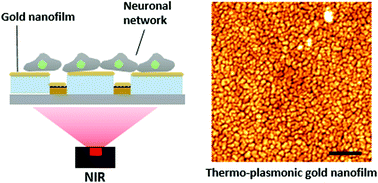Thermo-plasmonic gold nanofilms for simple and mass-producible photothermal neural interfaces†
Abstract
In recent years, photothermal stimulation methods using plasmonic metal nanoparticles have emerged as non-genetic optical techniques in neuromodulation. Although nanoparticle-based photothermal stimulation shows great potential in the excitation and the inhibition of neural activity, the complex synthesis processes of the nanoparticles and the lack of large-area deposition methods can be limiting factors for the development of photothermal neural devices. In this paper, we propose a plasmonic gold nanofilm, fabricated by a standard thermal evaporation process, as a simple and mass-producible photothermal neural interface layer for microelectrode array (MEA) chips. The absorption of the gold nanofilm at near infrared wavelengths is optimized to maximize the photothermal effect by varying the thickness and microstructure of the gold nanofilm. With the optimized conditions, a significantly strong photothermal effect is applied on MEAs without affecting the neural signal recording capability. Finally, primary rat hippocampal neuronal cultures are used to show that the photothermal neural inhibition using the gold nanofilm is as effective as that using the plasmonic nanoparticles. Due to the greater simplicity and versatility of the fabrication process, the plasmonic gold nanofilm can provide a promising solution for the mass production of photothermal platforms.



 Please wait while we load your content...
Please wait while we load your content...